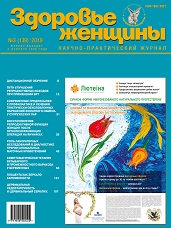Особливості контрольованої стимуляції яєчників у поганих відповідачів
DOI:
https://doi.org/10.15574/HW.2019.139.53Ключові слова:
контрольована стимуляція яєчників, погані відповідачі, корифолітропін-α, інгібітори ароматазиАнотація
Мета дослідження: визначення оптимального протоколу стимуляції яєчників у жінок зі зниженою оваріальною відповіддю з дослідженням його ефективності за кількістю отриманих ооцитів, дроблення ембріонів, показниками вагітності та імплантації.
Матеріали та методи. Проведено дослідження ефективності схеми контрольованої стимуляції яєчників у жінок–поганих відповідачів з використанням пролонгованого фолікулостимулювального гормону (ФСГ) у протоколі із застосуванням антагоністів гонадотропін-рилізинг-гормону порівняно з модифікованим протоколом з поєднанням застосування інгібіторів ароматаз (летрозол) та гонадотропінів.
Результати. Доведено, що стимуляція яєчників із використанням корифолітропіну-α та інгібітору ароматази є ефективною у лікуванні пацієнтів з поганою реакцією на стимуляцію. Cприйняття пацієнтами протоколів із застосуванням корифолітропіну-α доводить кращу переносимість порівняно з традиційними протоколами у зв’язку з меншою кількістю ін’єкцій, що знижує ймовірність дострокового припинення лікування. Модифіковані протоколи з вкористанням інгібіторів ароматази слід застосовувати у випадках оптимізації фінансових витрат під час проведення протоколу контрольованої стимуляції овуляції при схожому результаті.
Заключення. Представлені результати дослідження доводять ефективність застосованих схем з метою контрольованої стимуляції яєчників у поганих відповідачів. Використання корифолітропіну-α та інгібітору ароматази летрозолу у поєднанні з додатковими дозами ФСГ та антагоністами гонадотропін-рилізинг-гормону спрощує дизайн схеми стимуляції, мінімізує кількість ін’єкцій зі скороченням тривалості циклу та оптимізує фінансові витрати пацієнток.
Посилання
Polyzos NP and Devroey P. 2011. A systematic review of randomized trials for the treatment of poor ovarian responders: is there any light at the end of the tunnel? Fertility and Sterility 96;5: 1058.e7–1061.e7. View at Publisher · View at Google Scholar. View at Scopus. https://doi.org/10.1016/j.fertnstert.2011.09.048; PMid:22036048
Keay SD, Liversedge NH, Mathur RS and Jenkins JM. 1997. Assisted conception following poor ovarian response to gonadotrophin stimulation. The British Journal of Obstetrics and Gynaecology 104;5:521–527. View at Publisher. View at Google Scholar. View at Scopus. https://doi.org/10.1111/j.1471-0528.1997.tb11525.x; PMid:9166190
Ben-Rafael Z, Bider D, Dan U, Zolti M, Levran D and Mashiach S. 1991. Combined gonadotropin releasing hormone agonist/human menopausal gonadotropin therapy (GnRH-a/hMG) in normal, high, and poor responders to hMG. Journal of In Vitro Fertilization and Embryo Transfer 8;1: 33–36. View at Publisher. View at Google Scholar. View at Scopus. https://doi.org/10.1007/BF01131588; PMid:1826724
Jenkins JM, Davies DW, Devonport H, Anthony FW, Gadd SC and Watson Masson RHGM. 1991. Comparison of “poor” responders with “good” responders using a standard buserelin/human menopausal gonadotrophin regime for in-vitro fertilization. Human Reproduction 6;7: 918–921. View at Google Scholar. View at Scopus. https://doi.org/10.1093/oxfordjournals.humrep.a137459; PMid:1761658
Surrey ES and Schoolcraft WB. 2000. Evaluating strategies for improving ovarian response of the poor responder undergoing assisted reproductive techniques. Fertility and Sterility 73;4:667–676. View at Publisher. View at Google Scholar. View at Scopus. https://doi.org/10.1016/S0015-0282(99)00630-5
Kolibianakis EM, Venetis CA, Diedrich K, Tarlatzis BC and G. Griesinger. Addition of growth hormone to gonadotrophins in ovarian stimulation of poor responders treated by in-vitro fertilization: a systematic review and meta-analysis. Human Reproduction Update 15;6:613–622, 2009.View at Publisher · View at Google Scholar · View at Scopus. https://doi.org/10.1093/humupd/dmp026; PMid:19561136
Ferraretti AP, La Marca A, Fauser BCJM, Tarlatzis B, Nargund G and L. Gianaroli. ESHRE consensus on the definition of “poor response” to ovarian stimulation for in vitro fertilization: the Bologna criteria. Human Reproduction 26;7:1616–1624, 2011. View at Publisher. View at Google Scholar. View at Scopus. https://doi.org/10.1093/humrep/der092; PMid:21505041
Faddy MJ, Gosden RG, Gougeon A, Richardson SJ and Nelson JF. Accelerated disappearance of ovarian follicles in mid-life: implications for forecasting menopause. Human Reproduction 7; 10:1342–1346, 1992. View at Google Scholar. View at Scopus. https://doi.org/10.1093/oxfordjournals.humrep.a137570; PMid:1291557
de Ziegler D, Borghese B and C. 2010. Chapron, Endometriosis and infertility: pathophysiology and management. The Lancet 376;9742:730–738. View at Publisher. View at Google Scholar. View at Scopus. https://doi.org/10.1016/S0140-6736(10)60490-4
Benaglia L, Somigliana E, Vighi V, Ragni G, Vercellini P and Fedele L. 2010. Rate of severe ovarian damage following surgery for endometriomas. Human Reproduction 25; 3:678–682. View at Publisher. View at Google Scholar. View at Scopus. https://doi.org/10.1093/humrep/dep464; PMid:20083485
##submission.downloads##
Опубліковано
Номер
Розділ
Ліцензія
Авторське право (c) 2019 Здоров’я жінки

Ця робота ліцензується відповідно до Creative Commons Attribution-NonCommercial 4.0 International License.

